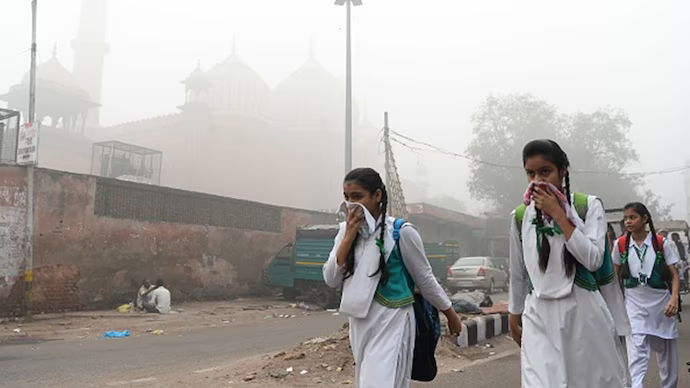Begusarai Struggles to Breathe: Can India’s Most Polluted City Find Clean Air Solutions?

Image Source: India Today
Begusarai, once known for its rich cultural heritage, is now shrouded in a different kind of cloud—a cloud of pollution. The city’s geographic and climatic conditions exacerbate the pollution. Located in the Gangetic Plain, Begusarai experiences low wind speeds during the winter months, leading to the accumulation of pollutants. The lack of sufficient green cover in and around the city does little to mitigate this effect, creating a situation where bad air days are the norm rather than the exception.
In a recent revelation that has stirred both concern and curiosity, Begusarai in Bihar has been named the most polluted city globally by the World Air Quality Report 2023, released by a Swiss technology firm, IQAir. This report, placing Begusarai above industrial behemoths and bustling capitals, has shone an unexpected spotlight on this otherwise unremarkable town in eastern India. Alongside Begusarai, several other Bihar towns—Siwan, Saharsa, Katihar, Bettiah, Samastipur, and Arrah—find themselves on the notorious list of the top 15 most polluted cities across Central and South Asia, with Lahore, Pakistan, being the only non-Indian city to make the list.
This shocking distinction has led many to question: Why Begusarai? A metropolis not regarded for heavy industries or full-size vehicular emissions, its ascent to the top of this dismal rating has confused experts and laypeople alike. Sachchida Nand Tripathi, a renowned air pollution professional from IIT Kanpur, offers a few insights that might help unravel this thriller. According to him, the primary culprits can be the burning of stable fuels and possibly stable waste, a speculation that points to home conduct as opposed to business activities as the primary source of pollution.
The report by IQAir, which also markets air purifiers and quality monitors, bases its findings on information from a mixture of regulatory air quality tracking devices and low-cost sensors operated by a wide array of entities, such as government groups, educational institutions, and male or female citizens. However, the highlight on Begusarai and its fellow Bihar cities raises crucial questions about the adequacy and insurance of the facts used to declare them the most polluted.
Dr. Tripathi’s work with the AMRIT community, an ambitious assignment to display air quality across Bihar with over 500 sensors, shows an exclusive story is probably unfolding. Early records point out that pollution stages across Bihar cities don’t vary as considerably as one would possibly assume, and several districts may also genuinely enjoy worse pollutants than Begusarai. This community, which is most effective and currently became operational, promises to offer a greater nuanced knowledge of the challenges facing the challenges facing the air in Bihar.
Dr. Tripathi’s mention of pollutant transportation from different areas underscores the venture of transboundary pollution. Air pollutants now do not respect political borders, and pollution can travel lengthy distances, affecting air quality in areas a long way from the supply. This phenomenon necessitates regional cooperation and coordinated coverage responses, highlighting the need for collaborative efforts across state and country-wide limitations.
The reliance on sparse and likely inadequate tracking records to pinpoint the most polluted areas brings to light the complexities of accurately assessing air quality on a worldwide scale. While the ratings provide an image of a pressing public health disaster, professionals caution against drawing definitive conclusions about specific localities without a comprehensive and sturdy dataset.
The high pollution levels in Begusarai and similar towns have profound socio-economic implications, affecting public health, labour productivity, and even educational outcomes. Air pollution is linked to a number of health issues, from breathing conditions to cardiovascular illnesses, leading to increased healthcare fees and a burden on public health devices. Furthermore, pollutants can deter investment and tourism, impacting local economies.
The unfolding narrative of Begusarai’s air quality crisis is a testament to the broader environmental challenges facing not just India but the world at large. It emphasises the need for extensive monitoring, collaborative research, and community engagement in tackling pollution.
As Bihar begins to uncover the intricacies of its air quality issues through initiatives like AMRIT, the hope is that more informed, effective, and localised solutions will emerge, moving beyond sensational headlines to breathe new life into the fight for cleaner air.
The story of Begusarai’s air quality serves as a call to action for researchers, policymakers, and civil society. It highlights the need for continued research to better understand the sources and impacts of air pollution, the development of more accurate and comprehensive monitoring systems, and the formulation of policies that are not only effective in reducing pollution but also inclusive and equitable.
As more data becomes available through initiatives like the AMRIT network, it will be possible to tailor interventions more precisely and to track the progress of efforts to improve air quality. In sum, the case of Begusarai is a microcosm of the global challenge of air pollution, offering lessons on the importance of data, the need for comprehensive policy approaches, and the value of community engagement in environmental health issues.
Team Profile

- Content Editor
- Yangchula Bhutia is a budding journalist currently pursuing her Master's degree in Journalism at Jadavpur University. Her passion lies in environmental issues, and she aspires to make a difference through impactful storytelling focused on environmental challenges and solutions.
Latest entries
 English7 September 2024India Leads Global Plastic Waste Production, Generating 10.2 Million Tonnes Annually: Study Finds
English7 September 2024India Leads Global Plastic Waste Production, Generating 10.2 Million Tonnes Annually: Study Finds English19 August 2024Indian Student at UCL Develops Carbon-Capturing Construction Material
English19 August 2024Indian Student at UCL Develops Carbon-Capturing Construction Material English17 August 2024Delhi’s Indira Gandhi International Airport Achieves Net Zero Carbon Emission Status
English17 August 2024Delhi’s Indira Gandhi International Airport Achieves Net Zero Carbon Emission Status English30 July 2024WhatsApp Enhances Message Reactions with New Double-Tap Heart Emoji Feature
English30 July 2024WhatsApp Enhances Message Reactions with New Double-Tap Heart Emoji Feature





